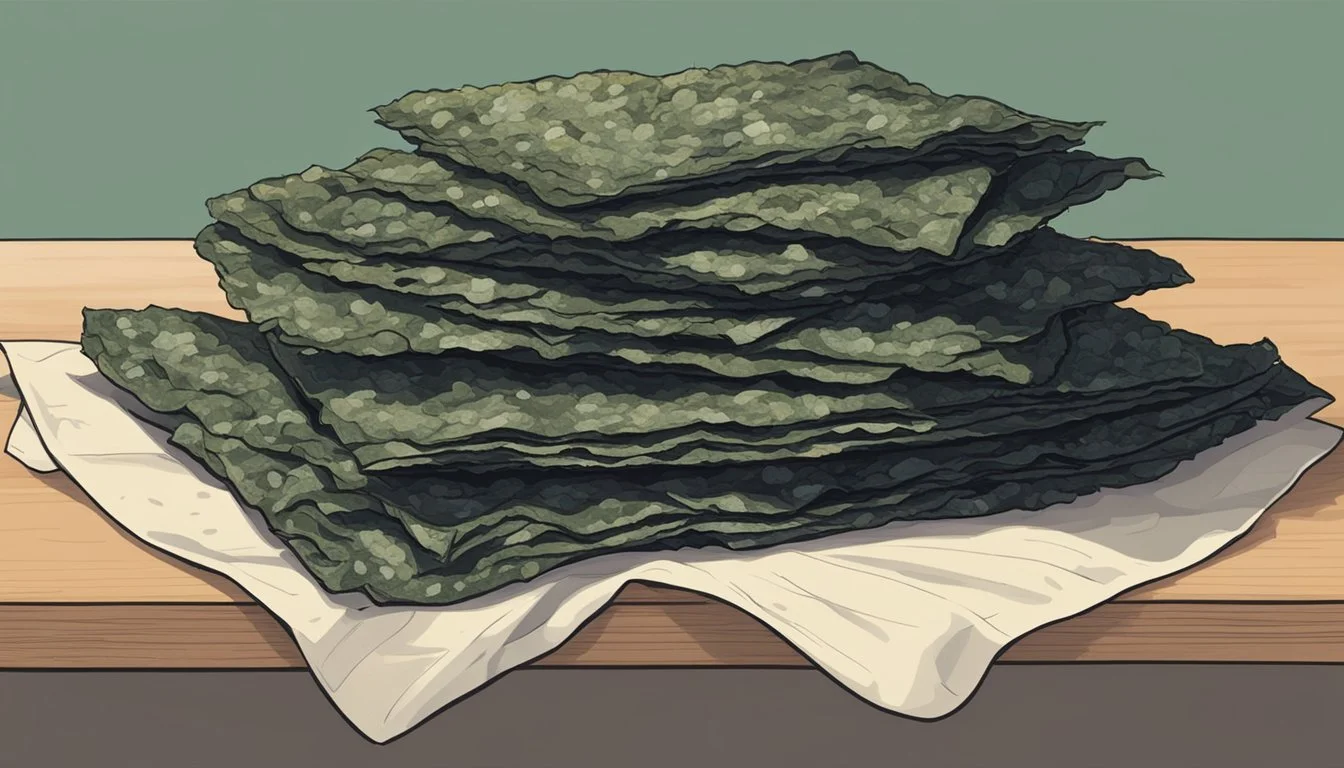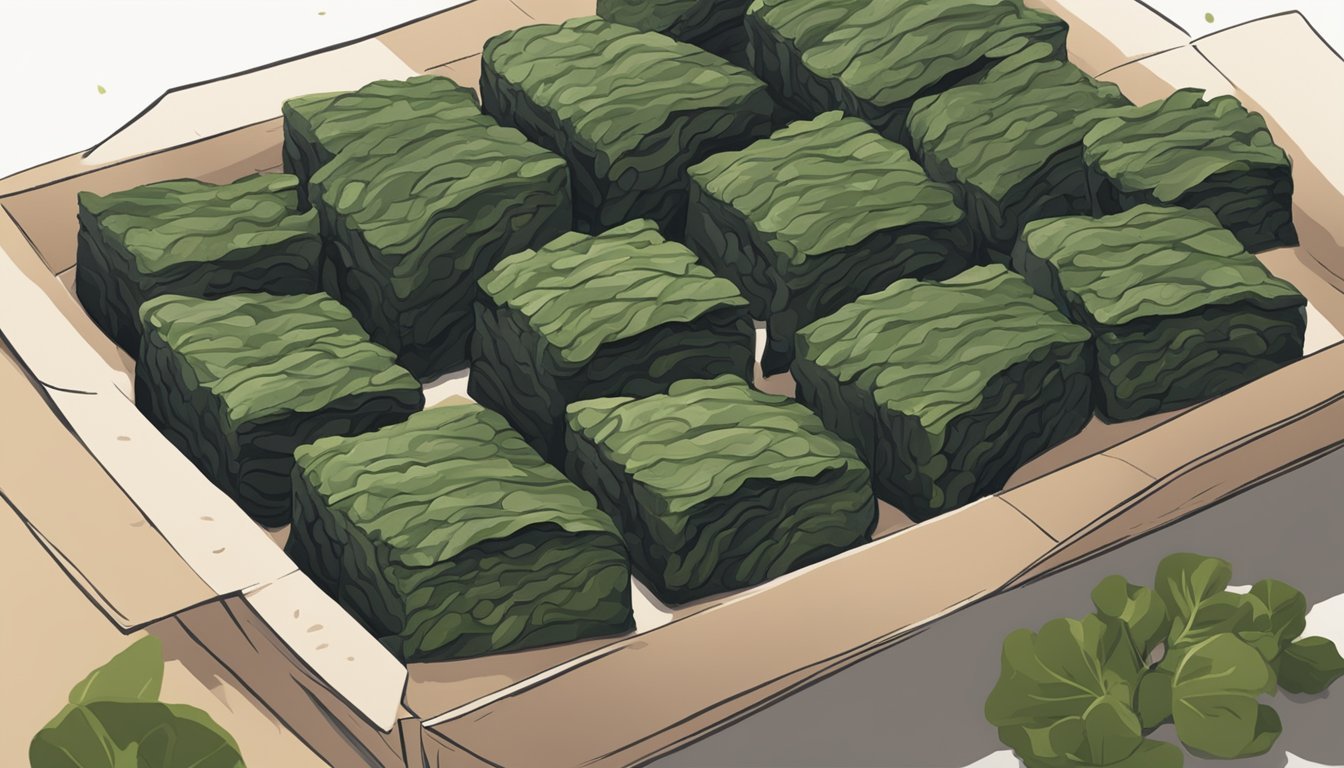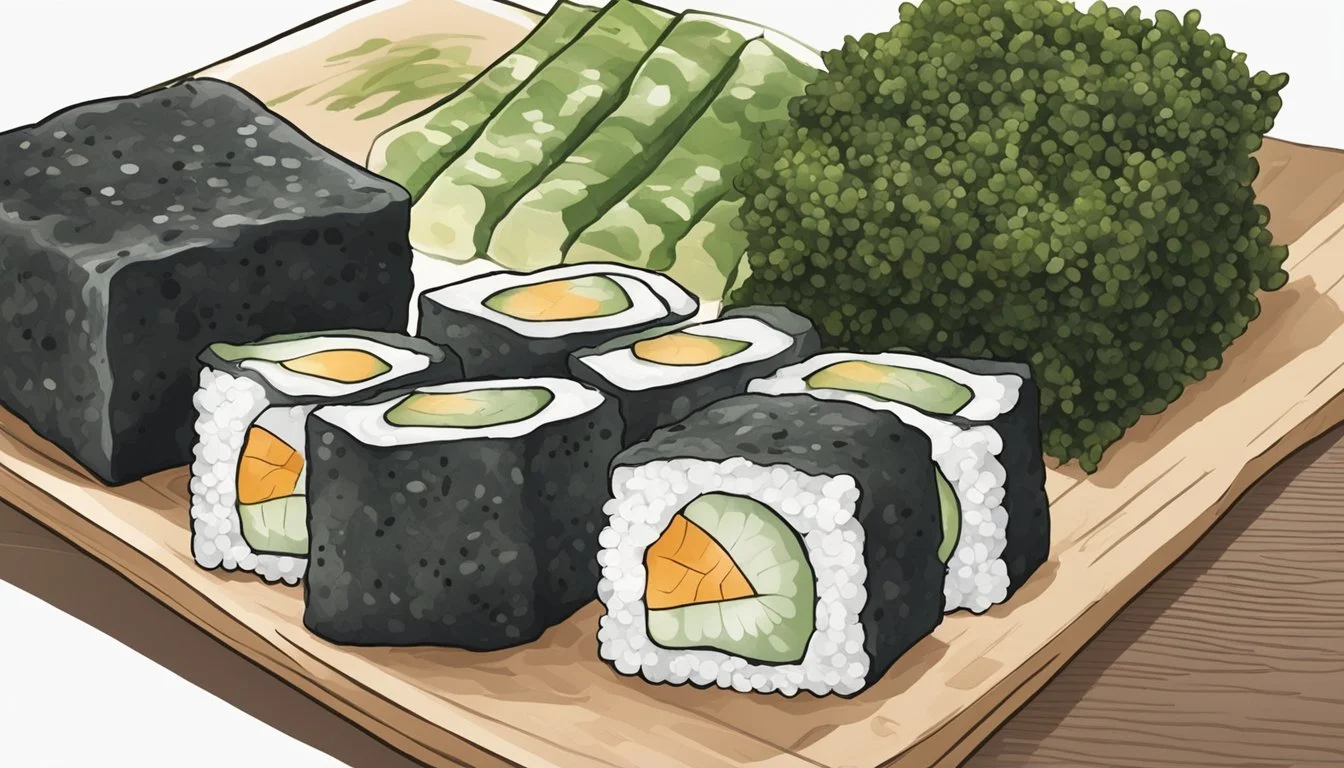Does Nori Go Bad? Shelf Life and Storage Tips
Nori, a type of edible seaweed, is a staple in Japanese and Korean cuisines. It's widely used in dishes like sushi, onigiri, and various soups and salads due to its unique umami flavor. An essential question for any nori enthusiast is, does nori go bad? Yes, nori can deteriorate in quality over time, especially if not stored properly.
When stored in a cool, dry place, unopened nori can last for up to two years. Once opened, it's crucial to keep the nori sheets in an airtight container to retain their texture and flavor. Signs that nori has gone bad include changes in color, a significant loss of flavor, or the presence of mold. This degradation makes it unsuitable for use in your favorite Japanese or Korean dishes.
Nori not only enhances the taste of sushi and other dishes but also offers numerous health benefits, being rich in vitamins and minerals. Understanding how to properly store and identify spoilage in nori ensures that you can enjoy its benefits and flavors without compromising on quality.
Understanding Nori
Nori, a type of dried seaweed, is rich in essential minerals and vitamins that offer various nutritional benefits. It plays a significant role in different cultural cuisines, adding both flavor and health benefits to a wide range of dishes.
Types and Uses
Nori is commonly available in several forms, including nori sheets and roasted seaweed snacks. Nori sheets are often used in sushi rolls, where they serve as a wrapping. These sheets can also be shredded and sprinkled on top of dishes like ramen or salads for added texture and flavor.
Roasted seaweed snacks are typically enjoyed as a convenient and nutritious snack. They can be consumed directly from the package or used as a garnish. Both types are appreciated for their high iodine content, which supports thyroid function.
Nori in Cultural Cuisine
Japanese cuisine heavily features nori, especially in sushi and onigiri (rice balls). It's also used in Korean cuisine, where it's known as gim and often paired with rice and vegetables. In both cultures, nori is celebrated for its unique taste and nutritional benefits, including high levels of iron, calcium, and other minerals.
Nori contributes to bone health and provides vital nutrients. It's popular in seaweed salads and is a key ingredient in many Asian dishes. The versatility of nori allows it to be incorporated into various meals, making it a staple in many households.
Assessing Freshness and Quality
Nori's freshness and quality are critical for maintaining its flavor and texture. A few key indicators can help determine if nori is still good to use.
Fresh nori should have a dark green, almost black color. This hue indicates it has been properly dried and stored. Discoloration, such as lighter patches or a complete change to a darker green or black, often suggests spoilage.
The texture of nori is another crucial factor. Fresh nori will feel crisp and dry. If nori becomes mushy or has soft spots, it may no longer be suitable for consumption.
Aroma and taste are also telling signs of nori's freshness. Fresh nori has a mild, slightly oceanic smell. If there's a strong, undesirable odour, it likely indicates the nori has gone bad. The taste should be pleasant and subtly savory. Any off-flavors are a clear warning sign.
In summary:
Indicator Fresh Nori Spoiled Nori Color Dark green, almost black Discolored, lighter patches, very dark Texture Crisp, dry Mushy, soft spots Aroma Mild, slightly oceanic Strong, undesirable odour Flavor Pleasant, subtly savory Off-flavors
Regular checks of these indicators can help ensure that your nori remains fresh and safe to eat. Proper storage in a dry, cool place is essential to maintaining its quality.
Shelf Life of Nori
Nori, known for its long shelf life, can remain fresh for years when stored properly. Its longevity depends on factors such as packaging, storage conditions, and whether the pack is opened or unopened.
Unopened Packs
Unopened packs of nori typically exhibit a shelf life ranging from 2 to 3 years. The packaging includes a best before or best by date, which serves as a quality indicator.
If stored in a cool, dry place away from direct sunlight, unopened nori can maintain its flavor and texture for a long period. Proper storage helps in preventing moisture from seeping through the packaging, which is crucial for keeping the seaweed dry and crispy.
After Opening
Once a nori pack is opened, its shelf life reduces significantly, usually lasting a few weeks to a couple of months. Using resealable bags or airtight containers can help extend its freshness.
Opened nori is more susceptible to moisture and air, which can lead to the seaweed turning soft or stale. Storing opened nori in a cool, dry place and using a desiccant packet can further help in extending its usability.
Expiration and Safety
Nori packages come with expiration dates, indicating the period when the product is at its peak quality. Consuming nori past its expiration date doesn't necessarily pose a safety risk but may affect its taste and texture.
Spoiled nori often shows signs such as discoloration, unusual odors, or a change in flavor. If nori appears questionable, it's best to avoid consumption. Proper storage and paying attention to expiration dates are key to enjoying nori safely and at its best quality.
Signs of Spoilage
Nori, while having a long shelf life, can go bad if not stored correctly. Identifying spoilage early helps prevent consumption of unhealthy nori.
Visual Indicators
Spoiled nori often has visible discoloration. Look for spots or patches that deviate from its typical dark green color. Mold may appear as white or green fuzzy growths on the surface.
Nori that has gone bad may also show signs of brittleness. Whereas fresh nori is pliable and slightly shiny, spoiled nori will look dull and may crumple easily. Dehydration spots can be another indicator; these may appear lighter and more opaque than the rest of the sheet.
Texture and Smell
Fresh nori should have a crisp texture but should not be overly dry or brittle. If nori feels excessively dry, it is likely stale. Conversely, a damp or softened texture indicates that nori has absorbed moisture, which can lead to spoilage.
The smell is another critical indicator. Fresh nori has a subtle oceanic scent. Spoiled nori may emit a fishy or moldy odor, signaling the onset of spoilage. A strong or unpleasant smell should be a clear warning to discard the nori to avoid potential food poisoning.
Proper Storage Methods
Proper storage of nori ensures its optimal freshness, longevity, and flavor. It is crucial to keep nori away from moisture, light, and air to protect its quality. Here’s how to store nori effectively:
In the Pantry
Store nori in a cool, dry place, such as a pantry or cupboard. Avoid areas with high humidity, as exposure to moisture can cause the seaweed to become soft or moldy. Keeping nori away from direct light also helps preserve its quality.
Store nori sheets in airtight containers or resealable plastic bags to minimize air exposure. Use silica gel packets or other desiccants within the container to absorb any moisture and keep the nori dry. Maintaining a stable environment in the pantry is key to prolonging the shelf life of nori.
Refrigeration and Freezing
For longer storage, refrigeration can be an option. Keep nori between 35-38 degrees Fahrenheit to prevent bacterial growth. Store it in airtight containers or resealable plastic bags to avoid condensation and moisture buildup inside the refrigerator.
When storing in the freezer, use similar precautions. Nori can be stored in the freezer if you plan to use it infrequently. Ensure the seaweed is well-sealed to protect it from freezer burn and to maintain its crisp texture. Label the container or bag with the date to keep track of its storage duration.
Using Desiccants
Desiccants like silica gel packets are highly effective in keeping nori dry by absorbing excess moisture. Place a few silica gel packets in the container or bag with the nori to ensure a low-humidity environment.
These packets are commonly available and can be reused multiple times. They help maintain a consistent dryness level, especially important in humid climates. Regularly check and replace the desiccants if they become saturated.
Resealing and Repackaging
After opening a package of nori, it’s essential to reseal it properly to maintain its freshness. Use resealable plastic bags or airtight containers to store any unused sheets. Removing as much air as possible from the storage bag helps prevent the nori from becoming stale.
Consider using a vacuum sealer for even better results. Labeling the bags with the date of repackaging can also help you keep track of how long the nori has been stored. Being meticulous about resealing and repackaging extends the shelf life and preserves the quality of the nori.
Impact of Environmental Factors
Environmental factors such as temperature, humidity, light, and air exposure play a crucial role in determining the shelf life and quality of nori. Each of these factors can significantly affect its freshness and texture.
Temperature and Humidity
Nori's longevity is heavily influenced by temperature and humidity. Storing nori in a cool environment, ideally between 35 and 38 degrees Fahrenheit, helps maintain its quality. Temperatures above 40 degrees Fahrenheit can lead to bacterial growth and degradation.
High humidity levels can also deteriorate nori by making it chewy and less crisp. Moisture quickly gets absorbed by nori, causing it to lose its desirable texture. Therefore, it's vital to store nori in a dry place to mitigate the negative impact of humidity.
Light and Air Exposure
Nori is sensitive to both light and air exposure. Direct sunlight can degrade its quality, causing it to lose coloration and nutritional value. Hence, it is advisable to keep nori in a dark place or in opaque packaging to minimize light exposure.
Exposure to air can lead to the absorption of moisture and odors from the environment. This not only diminishes its flavor and crispness but also shortens its shelf life. To counteract this, nori should be stored in airtight containers to maintain its freshness and taste.
In summary, optimal storage conditions for nori require controlling temperature, limiting humidity, and minimizing exposure to light and air.
Tips for Preserving Nori
Preserving nori involves proper handling and storage to maintain its quality and usability. Utilizing methods like refrigeration or freezing can extend its shelf life and help avoid food waste.
Proper Handling
Storage Methods: Nori should be stored in a cool, dry place. Keeping it between 35 and 38 degrees Fahrenheit is optimal. Refrigeration is better than placing nori in a cupboard, as it prevents bacterial development that starts at 40 degrees Fahrenheit.
Sealed Packaging: Keeping nori sealed is crucial. If the package is opened, transfer the nori to an airtight container to prevent exposure to air and moisture. Properly sealed, nori can last 2-3 years unopened and several months once opened.
Freezing Nori: If you use nori infrequently, freezing is an excellent option. Place the nori in a freezer-safe bag to extend its shelf life significantly. This method is especially useful if you stock up on nori.
Avoiding Food Waste
Best-By Date: Nori often has a best-by date rather than an expiration date, meaning it can be safe to consume past this date if stored correctly. Regularly check the nori for signs of spoilage such as discoloration, brittleness, or an off smell.
Using Nori as Garnish: To minimize waste, use nori in small amounts to garnish dishes. This practice helps in utilizing nori efficiently without letting large quantities go bad.
Regular Rotation: Practice FIFO (First In, First Out) when storing nori. This ensures that older packages are used first, reducing the likelihood of spoilage.
Naturally Salted: Some nori products are naturally salted, which can help preserve them longer. Check the packaging for this detail, as it may influence how long your nori stays fresh.
Creative Uses for Nori at Home
Nori is a versatile ingredient that can be creatively utilized in various dishes beyond traditional sushi rolls.
Recipes and Snacks
Nori sheets can be cut into small strips and used as snack wraps for ingredients like tofu or cucumber. Simply cut the sheets into 2-inch-wide strips, wrap around tofu or cucumber pieces, and secure with toothpicks. This creates a nutritious, bite-sized treat that pairs well with soy sauce or other dipping sauces.
Garnish for Flavor
Toasted nori can enhance dishes as a crispy garnish. Sprinkle crumbled nori over salads or soups to add a burst of umami flavor. It also adds texture and visual appeal, making the dish more inviting.
Enhancing Salads and Other Dishes
Nori can easily be integrated into salads for added taste and nutrients. Tear the sheets into small pieces and mix them into green salads or cold pasta salads. It pairs well with soy sauce-based dressings, bringing a unique, savory touch.
Make Your Own Sushi
While traditional sushi rolls are common, nori can also be used for hand rolls or even deconstructed sushi bowls. For hand rolls, wrap nori around a combination of rice, vegetables, and protein. For sushi bowls, serve all the ingredients in a bowl with nori sheets on the side.
Toppings for Rice Dishes
Nori can be cut into strips and used to top rice dishes or poke bowls. The dark green seaweed not only enhances flavor but also adds a nutritious element to the meal, making it a great complement to other ingredients.








